Trey Lauderdale is president of Voalte of Sarasota, FL.

Tell me about yourself and the company.
I’m the founder and the president of Voalte, founded in 2008. We’re about to celebrate our five-year anniversary. We focus on deploying and enabling smartphones at the point of care and outside of hospitals to enable secure text messaging, interfacing to alarms and notifications, and voice over IP communication within the hospital.
We’re installed over 30 sites and we’re nearing about 10,000 iPhones deployed in the field,which is a great milestone for the company. Beyond the software that’s offered, we provide all the service, accessories, really everything that is required to bring smartphones in as a shared device model.
Can smartphones finally kill pagers?
I think we’ve made a tremendous amount of progress over the last few years. We are not quite there yet. I think people always forget that while pagers are simple devices, the message or the notification that is sent to that pager can come from many, many different sources.
I’ll give a few examples. You have your shared pagers, which are using an in-house pager network to send notifications. Maybe those are used for a code blue or rapid response team. They’re passed on between caregivers at the beginning of shift. You have someone’s personal pager, which is used outside or inside the hospital, mainly to receive a notification and let someone call back in or just to notify someone of an urgent situation.
When you’re looking at a holistic pager replacement strategy, you need to segment off the different type of pagers and then figure out what’s the system that’s generating the alarm, whether it’s a manual alarm or someone is dialing a number and sending out for notification. While pagers are simple, the workflow behind them could be very complex. We’ve made tremendous strides as an mHeath industry in getting smartphones to replace pagers.
At Voalte, we’re focused at the point of care, getting rid of those shared devices whether it’s the legacy voice over IP phone or the shared pager model. With our solution, we can pretty much remove all the pagers that work predominantly inside the hospital.
When you start getting to someone’s personal pager that they are assigned, there are different technologies that can enable smartphones to be a virtual pager. Those are being rolled out as well, but across the board, we haven’t run into a hospital yet that’s been able to fully remove or replace all the pagers.
I feel a lot of the infrastructure and plumbing is in place. We still have a little bit of work to do from a workflow perspective. In healthcare in general, we tend to be resistant to change and people have grown to rely on their pagers. People have faith in that pager that the message is going to come through. I think we still have a few more years, but we’ve made a tremendous amount of progress since the last time we spoke. We’re getting there.
Pagers are cheap and cover a large area, but there’s some awful workflow when you get a page and then go find a phone or use your own phone to call someone back and then hope that they’re at the number that they paged you from.
That is probably one of the largest areas where pagers cause issues of workflow. I’m a nurse and I need to reach a physician, so I page that physician. Let’s say that they are using a legacy voice over IP phone. I’ll page them my extension. That physician that needs to receive the notification needs to find a phone, then call in to that nurse. A lot of times that nurse isn’t busy. That is just one example of how workflow can break down and then the physician will end up leaving a message with unit secretary. The unit secretary had to overhead page the nurse. The nurse might be in a patient room and misses the overhead page.
You can just see how you get in this vicious cycle. That’s a combination of issues that are caused from legacy pager technology but also legacy phone technology being used at the point of care.
Where you would establish the correct workflow is the nurse would use a shared device, a shared iPhone model, where they can come in, see a physician that is logged in, and simply send them a message and then the physician can respond back. If you look at what we’re doing, it’s not that complicated. It’s enabling the communication functionality that you and I use in our personal lives right now, enabling that in a very secure, controlled, and regulated manner.
People who haven’t worked in a hospital would be surprised on how much people rely on Amcom Smart Web. Users call it texting, where you’re going to a PC, composing and sending a message either to an individual pager or functional pager, and walking away. That person gets the message, they go back to a PC, and respond back to you through Amcom Smart Web. It’s pretty amazing when you think of all the steps when the pager is the only device you have.
Oh, it’s incredible. I can’t imagine an industry that is more important than healthcare. We’re dealing with people’s lives, saving people from all sorts of terrible conditions. In healthcare, communication, even today, just hasn’t been paid attention to. We still have lots of pockets and silos of communication.
At companies like Voalte, our goal is to start breaking down those walls. When we started the company, our real focus was at the point of care, removing the legacy VoIP phones. Now as we continue to grow, we see that reach expanding not only the inside of the hospital, but inside and outside the hospital as well.
What do people do with your platform?
Voice communication is the most difficult to get to work well, mainly because there are so many moving parts with voice over IP. There is a device, our application, and the wireless network. Voice tends to be used the least amount on the Voalte solution.
Beyond voice — the second two letters in our name, AL, is for alarms and notifications — we interface with all of the leading middleware providers. The creator of that space was Emergin, but we also tie to Connexall, Amcom Extension, and Cerner Alertlink. We can receive notifications from those different middleware providers with different priorities and then play different ringtones on the device based on the priority of those notifications.
We then enable workflow off those alarms, such as accepting a notification or rejecting a notification, or other functions such as calling back to the nurse call system if the nurse call enables call-back functionality. It’s the capability not just to receive the notification, but to take some type of simple action upon the alarm or notification that sent.
The final component is the secure messaging. Inside each hospital where we’re installed, we have a directory of all the users based on units, roles, and where they’re logged in. You can see who’s logged in at your specific unit and send secure messages back and forth.
We have all sorts of features built into our messaging to make it very simple and easy and intuitive to use. We borrow heavily from our friends at Apple from a user interface standpoint, so it’s very clean and easy. You can see when the message is sent, when the delivery of that message hits the device, when it’s read. It’s very easy to have a conversation back and forth.
We said it three years ago in our last interview and I’ll say it again. Text is used usually at a nine-to-one ratio compared to voice calls. The reason for that is texting is an asynchronous form of communication. I can message you. When you’re available, you can then message me back, whereas voice is real time. For you and I to talk like we’re doing right now, I have to be available and you have to be available. Our caregivers are just so busy taking care of patients. It’s very rare they have time to make a phone call.
Our infrastructure enables those real three foundations of communication to be put in place. What we see happening now, really it’s been over the last year, is the leading electronic medical record companies, the leading EMR vendors, are all either developing or they have developed their nurse-centric application. They need a way to deploy that, provision it, get it out to a shared device model. We’ve been able to partner with the leaders in that space to enable the EMR application to live alongside of Voalte. Then we figure out ways to integrate tighter with the EMR and more advance functionality on the iPhone. I think the EMR vendors jumping into this space has really been a great catalyst for our growth over the last year or year and a half.
The alarm issue is important because it’s now a National Patient Safety Goal. Are people calling you specifically to talk about that?
Yes. We get contacted about the National Patient Safety Goal, alarm fatigue, different issues with receiving alarms and notifications in a user-friendly format. However, looking specifically at the National Patient Safety Goal of improving response to clinical alarm and overall management, I feel the alarm management space is very much in its infancy.
My previous employer was Emergin, which is now a Philips company. Michael McNeal, who was the CEO of Emergin, created the alarm management space within healthcare. Over the last probably seven to eight years, what we’re saying is a lot of the plumbing and integration is being put in place. Being able to tie it to Philips monitor with the Rauland nurse call, your GE monitor, the infusion pumps, the capability to receive those alarms … a lot of work has been done there.
However, what we’re ending up with this is a situation where we can pass the alarms, we can route them to the right caregiver or the right care team, but we still have the issue of too many alarms and too many notifications still going to our end user. Even on a Voalte device, we can do a great job of displaying these alarms and associating ringtones with these notifications, but if we get blasted in with 10 alarms in a one-minute period, we’re still going to dispatch – we being Voalte — those 10 alarms and notifications. It’s going to be overwhelming for the end user.
To our knowledge, and what I’ve seen in the space, is no middleware company or no alarm management company has tackled the problem of creating smart alarms or building algorithms based on the different types of alarms that are coming in and finding a way to reduce those alarms to just what is relevant to the caregiver. I think that is a tremendous opportunity. I’m not quite sure who’s going to tackle it, but I think we’ve made a lot of strides in getting the notification to the right person in the right place at the right time. What we have to do now is get smarter about sending the alarms.
There’s a lot of responsibility in intercepting those alarms and deciding which ones to squelch out. Is that a concern as far as regulatory or legal exposure if something goes wrong?
Absolutely. That is one of the reasons that we haven’t seen as much innovation in that space — if your people are very afraid of not sending an alarm that actually does need to get sent. We haven’t seen anyone ready to tackle that big, hairy, audacious problem. But as the founder of a startup in the health IT space, my recommendation is someone needs to tackle that. Someone needs to go and figure out how to do that in the FDA regulated format. Whoever does it is going to create a very successful company.
I’d love to go do it except I’ve got my hands completely full of Voalte right now. But I do think that’s one of the limitations we see, but it will get solved and it’s going to get solved in the next few years. I think it’s going to be a very exciting time for alarms and notifications. It’s a space that we watch very closely.
Are the monitor vendors generally cooperative and interested in working with other companies?
We don’t have the relationship with Philips or GE that we would know if they’re working on tackling this problem, so I really can’t speak to what progress they have made. But I would be under the assumption that hopefully they are putting work or resources towards those problems.
When I talked to Pat at University of Iowa Health Care, he mentioned Voalte Me. Tell me what that is.
Voalte Me is a product that we haven’t formally announced yet, so Pat got to announce our product. [laughs] In essence, what we’ve done is take the messaging and alarm functionality which is living within Voalte One to a shared device model space. We’re enabling that outside the hospital to support more of the BYOD — bring your own device — model, much more geared towards physician communication.
What we’ve found is communication inside hospitals is broken in two main segments. You have your shared device model, which is what Voalte One focuses on. Voalte Me is a product that we’re releasing in the next few months that enables a caregiver to use their personal phones to receive notifications and messages in a secure format. We’ve added extra security encryption into our application to enable that outside the hospital over the cellular network.
Do you see that as a trend where the personal phones of clinicians will be used for more corporate type applications?
Absolutely. The whole BYOD phenomenon — especially with the support of different mobile device management vendors that have come about, such as AirWatch and their capability of secured and controlled applications on someone’s personal device — has definitely opened up that whole space of letting a user or letting a clinician use their personal device for enterprise functionality.
From our standpoint, we feel that the Voalte One product line and what we built has a very specific use case. We’re getting rid of legacy voice over IP phones. We’re removing the legacy voice badges. We’re enabling a smartphone platform at the point of care that hospitals want to completely control, to be able to select what applications are put on the device such as the EMR application, Epocrates, calculators, etc.
Those caregivers who are using a shared device model and need to communicate with one another in the hospital, but they also have the need to send messages or to send notifications and alarms to those that are outside of the hospital with someone who is using their personal device. That is where the whole Voalte One, Voalte Me breakdown comes together.
AirStrip was an Apple darling, showing up on stage at some of the Apple announcements. Is Voalte that tight with Apple?
We actually have a phenomenal relationship with Apple. A lot of people like to coin Apple as a consumer-only company. They’ll say that Apple isn’t enterprise, they aren’t ready for enterprise, etc. From our perspective, it doesn’t have to be black and white. You don’t have to be consumer-only or enterprise-only.
I think Apple has done a great job at balancing that. If you look over the last few years, Apple has enabled lots of mobile device management functionality to add different layers of security to the iPhone and to the iPhone operating system. In addition, we at Voalte have worked very actively with Apple. We can’t sell iPhones directly to hospitals, but we work with specific business units within Apple. We have a great partnership where Apple will directly sell the iPhone without a cellular plan to the hospital. Apple has been very active from an AppleCare perspective with support of devices that had been damaged or broken and adding extra warranty protection of those devices.
In addition, as of recently, Apple has aligned with us from a wireless perspective. We at Voalte will go on site with our WiFi team and with Apple’s WiFi team in our larger installations to make sure that the devices are working properly in a wireless environment.
From our standpoint, Apple has been a phenomenal partner, from service, support, and also application development support. Our engineers get to work directly with Apple’s engineers. They have been a great partner in the enterprise. We hope to see that relationship continue to bloom.
Tell me about the size of the company and how you see it growing.
Just to give you a scale of our growth, at the beginning of this year, we were about 50 employees. As of August, we were 120, so we’ve already more than doubled in size. We’ll probably end this year around 150.
Over the past 12 to 18 months, the growth that we’ve experienced has just been incredible. It is as if a light switch suddenly turned on in our customer base and users and the hospitals are not accepting proprietary communication devices any more – the voice badges, the legacy voice over IP communication devices. The expectation our end users have is a smartphone type of communication because it’s what they use in their personal life.
Because of that, they have that same expectation and their professional communication at the point of care. No one except Voalte has been able to successfully deploy smartphones in a shared device model, get them to integrate to these clinical systems, and do that successfully over and over and over again.
Because of that and also our successful relationships with the EMR vendors, we’ve just seen tremendous growth. We’re definitely in that exponential growth phase. We’re hiring as quickly as we can. We recently moved to a new office and we’re already starting to fill it out, so we have to figure out where we continue to put all these employees. We’re getting ready to launch our West Coast office.
Across the board, we see our install base growing almost exponentially. We see our sales growing about the same rate. It’s just a really exciting time. When you hear about young companies who are startups going through that tornado phase of growth, that’s what we are in right now. It provides a lot of challenges, but it’s also very exciting.
The average company that is like yours would have taken outside money and then the dynamic of the company would change through all that growth as they brought in professional managers. Has that been an impact or will it be?
I can’t speak for the board, but I will say that I have been able to hold a phenomenal relationship with all of our board members and our investors. Part of it is building a great plan and being able to share with your board and with your investors where your immediate goals and your tactical goals that you want to achieve and what are your long-term strategic vision is. Then show success against that plan over and over and over again.
As we continue to look at our different options from a fundraising standpoint to continue to fuel the growth of the company, it’s all about execution. It’s about bringing the right people on board, such as Kenda West, our new COO that just came on. Making sure that these people have the right tools and the right resources to do amazing things. Really it’s just been about us executing our plan that has enabled us to be successful.
You started the company when you barely out of grad school. What have you learned?
The number one piece of advice I give to anyone who is looking at starting a company in this space is it’s all about the team. It is really about putting the right people in the right place. Make sure you foster your employees and build a culture of excellence. That trumps everything because “A” players will hire more “A” players and it just creates this upward momentum. That becomes unstoppable in the market.
The next thing is specifically looking at the acute care healthcare setting. It’s very, very difficult to get traction. What you need to do is find the early adaptors or innovators who are ready to embrace new and emerging technology. I can tell you for a fact that without Sarasota Memorial, Cedars-Sinai, University of Iowa, Texas Children’s, Mass General, without our early adaptors and development partners who helped us build this technology out, we would not be here. They were the ones who let us pilot new technologies. They were the ones who in some cases let us fail and didn’t give up on us and kept working with us to build the solution.
I think the two key pieces of advice are get the right team and build the right culture, and then on top of that find the right partners. You need the right customers who can embrace that type of risk and innovation. Then work like crazy from there because it’s a tremendous amount of work.
Do you have any final thoughts?
This is without a doubt the most exciting time to be in the communication space. We see smartphones being embraced like they’ve never been embraced before. We have the 800-pound gorillas in the health IT space, the EMR vendors, all embracing smartphones as well, so there is tremendous uplift.
On top of that, there are opportunities to improve physician communication, patient engagement, point-of-care communication, barcode sleeves for the iPhone. Across the board there is disruptive innovation and opportunities everywhere. I would not be surprised if in the next five to seven years, companies that are like Voalte or in Voalte’s position could have the potential to be the size of some of today’s large EMR vendors or other billion-dollar companies in the space.
The change is going to happen very, very rapidly. I feel Voalte is very well-positioned to capitalize on this opportunity and provide a really compelling and wonderful solution to our customers. We could not be happier. It’s an exciting time.
Thank you for the opportunity to talk to you. As always, your site is my favorite blog, and I’m not just saying that because you’re interviewing me. I’ve followed you since the Michael McNeal interview, my first day at Emergin, and I’ve read it ever since. I really appreciate all you do.


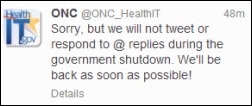





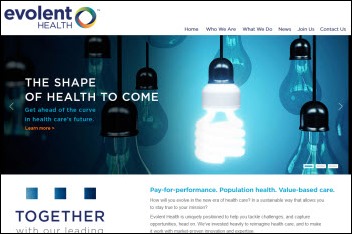
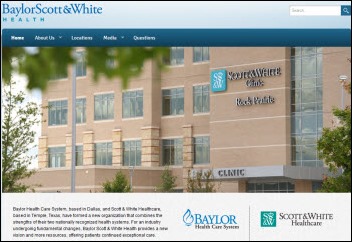


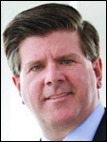


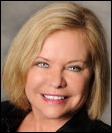




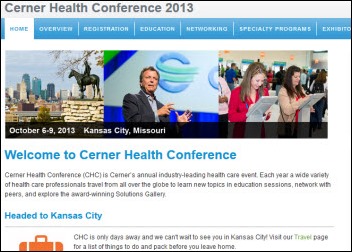
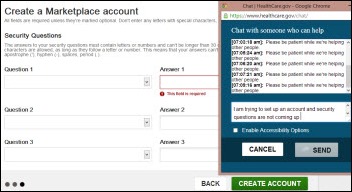
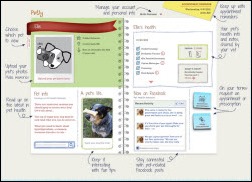





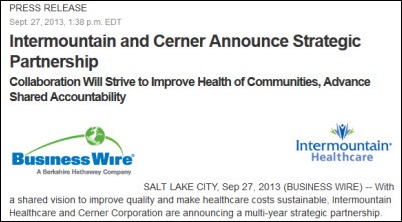


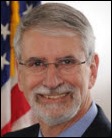



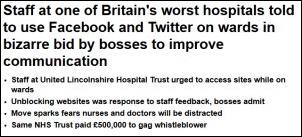
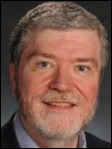




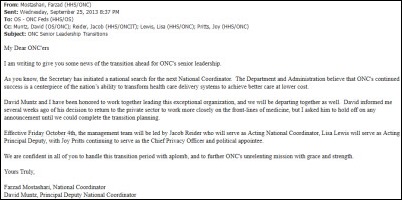
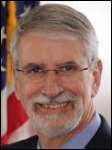
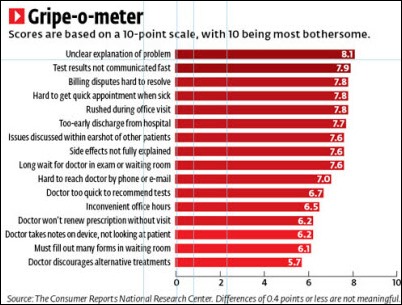

 A few highlights from
A few highlights from 


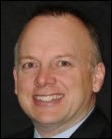




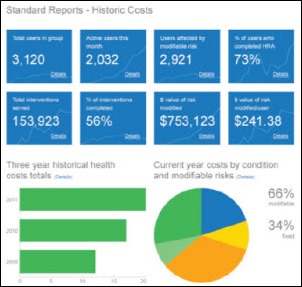
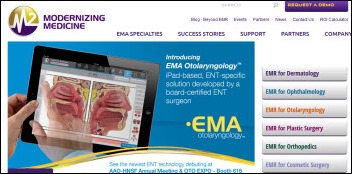












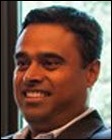
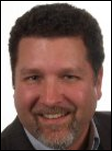


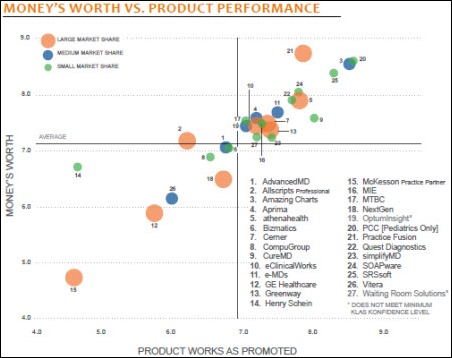

"most people just go to Epic" that's a problem because then EPIC becomes a monopoly in healthcare, if it isn't…